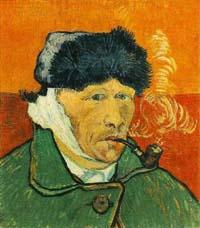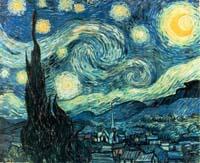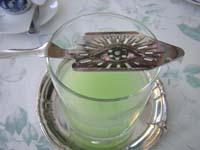Van Gogh in the eyes of scientists
2006/07/26 Galarraga Aiestaran, Ana - Elhuyar Zientzia

Self-portrait with pepper and tied ear. Compared to the paintings he made at that time, this is absolutely quiet
For example, in works prior to suicide — Starry Night (1889), Cypress Road and Stars (1890) and Wheat Field with Candles (1890), turbulent skies appear. However, the self-portrait he painted in 1988 does not appear.
The self-portrait is tied to the bell pepper and ear, and is much quieter than the rest. Van Gogh himself stated that in the elaboration of this painting he was completely calm. Apparently, when he cut his ear, they gave him potassium bromide and painted the picture under his influence.
But when he did the others he was not so calm. On the contrary, he suffered a psychotic crisis, with hallucinations and loss of knowledge. He also had epilepsy.
According to physicists, this confusion gave Van Gogh the ability to imagine turbulence and not in any case, they have shown that, correspond to the equation that explains the theory of turbulent flow!
Kolmogorov equation

They have shown that the trailers appearing on the starry night coincide with the mathematical equation.
Scientists have needed centuries to describe a turbulent flow that is not easy. There are those who think that the physics of the trailers is more complex than the quantum mechanics itself. Although not yet fully explained, the current theory is based on the work done by scientist Andrei Kolmogorov in the 1940s.
The Kolmogorov equation explains the probability of knowing the speed difference between any two points in the flow. Now, physicists have studied whether Van Gogh's swirls fit this equation.
To do this, they have taken digital images of the frames and calculated the probability that two separate pixels have the same brightness or brightness. Thus, in the whirlwinds painted by Van Gogh they have shown that the distribution of luminosity depends on the equation of Kolmogorov.
The physicists have not remained there, and have also studied the turbulent paintings of other painters to know if they meet the Kolmogorov equation. But it seems that Van Gogh was the only one. For example, in the painting of Eduard Munch de Garrasia numerous structures appear as trailers. In them, however, the distribution of luminosity does not correspond to the equation of Kolmogorov.
Motif of the color

Would Van Gogh use so much yellow for abusing the abenta? (Photo: Al Rose)
In addition to trailers, some scientists have focused on color. Specifically, researchers at the University of California wanted to know why Van Gogh used that yellow color.
Van Gogh apparently had epilepsy and the medication given to treat the disease had a collateral effect: he could produce xanthopsis, that is, see everything yellow. The same effect has the abuse of the abenta. The abenta was a fashionable drink of the time and Van Gogh was also amateur.
According to the researchers, both drugs and drinks can directly influence the work of Van Gogh. In fact, the yellow color was the protagonist of most of his paintings, and the house itself was totally painted yellow. Not by chance.
Published in Deia.




